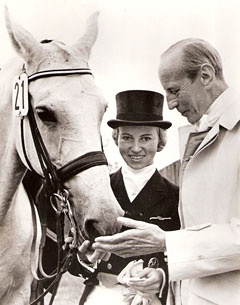
On a brilliant day at the end of May 1963 the traditional wild horse catch near the German town of Dülmen was taking place in front of several thousand interested spectators. Between them was the German businessman and successful dressage rider Josef Neckermann, who had won an Olympic individual bronze medal in Rome 1960.
Neckermann was, of course, not interested in buying one of the young colts which were caught and sold on the spot. He was guest of the Countess von Croy and attended a dressage display with two beautiful grey youngsters: The 9-year old mare Antoinette, ridden by Olympian Hannelore Weygand, and the identically aged gelding Mariano, ridden by German professional Herbert Behrendt. They performed a pas de deux, in which Behrendt tragically died of a heart attack. At that time Josef Neckermann could not never imagine that both horses would be his one day, but he fell in love with the then quite dark Holsteiner beauty Antoinette, who was clearly influenced by her thoroughbred sire Anblick xx. On her dam’s side she went back to Heintze, who can also be found in the dam line of the great Granat.
At the beginning of Antoinette’s life it didn’t seem she would become one of Neckermann’s greatest dressage horses ever and a heroine for the Holsteiner breed. She was born in March 1955 in Siethwende at breeder Karl Hans Harder’s farm and started her life as a riding horse in a riding club in Bremen under the name Amelie. Her undoubted beauty, her good conformation with a not too long back, her nice topline and good hindlegs soon made her interesting as a dressage prospect. Herbert Behrendt trained her up to S- level and after his unexpected death in the spring of 1963 his student Hannelore Weygand continued to train and compete the mare at Grand Prix level.
Of course Weygand was happy to receive the ride on such a horse after she had been on the silver medal winning German dressage team at the 1956 Olympics with the Trakehner gelding Perkunos (one of those legendary horses who reached the west by being smuggled in 1945). But Antoinette’s owner Hans Dütting intended to sell Antoinette and when Josef Neckermann heard of it he acted quickly.
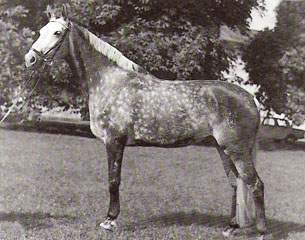
“My father was looking for a good dressage horse. When he heard Antoinette was for sale he immediately contacted her owner and in the summer of 1963 he bought her. Of course Hannelore Weygand was sad, but she understood the decision. Antoinette was the only horse for which my father had paid 100 000 DM (approx. 50 000 Euro), which was much money in 1963”, Neckermann’s daughter Evi Pracht told Eurodressage.
The sale was a hot topic on the dressage scene for weeks, because Antoinette was rated as one of the best young horses and several top riders would have liked to ride her. In 1963 Neckermann himself was in no urgent need of a Grand Prix horse, competing his Olympic mount Asbach successfully as well as his second and younger Hanoverian Förster. This latter gelding was to become his 1964 Olympic horse. This situation worked in Antoinette’s favour because her rider was in no need to hurry her sensitive progression on the training scale.
In October 1963 Neckermann took her to the Paris indoor show to start her in the small tour and there Antoinette proved for the first time what an extraordinary sensible horse she was. Evi Pracht remembered: “The whole thing turned out to be a kind of catastrophe! The mare didn’t go near the judges at C who sat in 2,5 m high military trucks. My father forced the spooky Antoinette to pass it in 10 m distance almost until the end. Then he pulled his hat and retired.” Though FEI level trained and already Grand Prix placed the Holsteiner mare showed that she clearly needed some basic training after Paris.
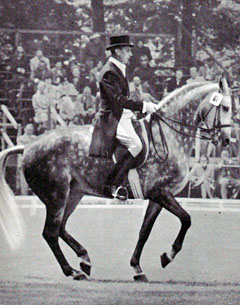 Josef Neckermann used the winter of 1963 -1964 to work on Antoinette’s suppleness and the soft bit contact. He was lucky not only to train regularly with the national coach, but to have an extraordinary groom: Fritz Baranowski, a man from East Prussia with a great talent in lunging horses. Antoinette got a lot of good lunging and was only ridden in a snaffle until she learned to use her back and hindlegs properly and avoided to pull her tongue high.
Josef Neckermann used the winter of 1963 -1964 to work on Antoinette’s suppleness and the soft bit contact. He was lucky not only to train regularly with the national coach, but to have an extraordinary groom: Fritz Baranowski, a man from East Prussia with a great talent in lunging horses. Antoinette got a lot of good lunging and was only ridden in a snaffle until she learned to use her back and hindlegs properly and avoided to pull her tongue high.
When the 1964 Olympic season got on its way Antoinette was a much improved horse, though not seriously considered to qualify for Tokyo. Neckermann intended to start his Hanoverian Förster there, a horse he had bought in 1961 as a 9 years old and which had won the Aachen Grand Prix in 1963. However Antoinette’s first Grand Prix start with Josef Neckermann at the renowned Berlin indoor show in January 1964 became a great success with the mare winning all her competitions. A week later at the Hannover show she earned the special prize for the horse with the best piaffe.
In fact Antoinette was a horse of a quality which was very rarely to be found in the 1960s. Her type was so noble and beautiful that she would have every chance of winning at shows even nowadays. Her trot was outstanding and her piaffe of such perfection that even today only few horses are able to show. With beautifully lowered hindlegs she demonstrated a clear rhythm with enough push from the ground. “Antoinette’s strength was her extended trot which was really unique. But also her piaffe, passage, the flying changes and the pirouettes were very good. Not so good was her half passes and her walk,” admitted Evi Pracht , who was beginning to make herself a name on the dressage scene in the 1960s aboard some nice thoroughbreds.
Despite her undoubted talent and quality Antoinette would not have been Neckermann’s first choice for the Olympics in Japan because she was the least experienced of his Grand Prix horses and moreover a very sensitive and shy soul. Evi Pracht disclosed to Eurodressage that Antoinette had always been a horse with lots of fear which led to her being spooky and environment orientated. However, fate stepped in at the end of February 1964 when Evi’s father lost his number one choice Förster due to a severe colic attack. At that time it could not be operated on like similar cases today.
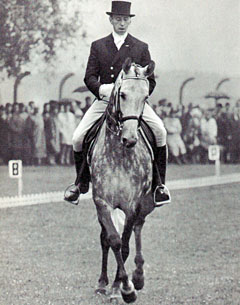 From one day to the other his grey prima donna, who exactly knew how exceptional and special she was, became his Olympic hope as his other Grand Prix horse, Asbach, was already 16 then. Antoinette coped brilliantly by winning the Grand Prix at Aachen in front of the other rivals applying for a place on the German dressage team. There was no doubt she would be nominated and even more so, she had the ability to beat the world elite which she would meet again at Tokyo at the end of October 1964.
From one day to the other his grey prima donna, who exactly knew how exceptional and special she was, became his Olympic hope as his other Grand Prix horse, Asbach, was already 16 then. Antoinette coped brilliantly by winning the Grand Prix at Aachen in front of the other rivals applying for a place on the German dressage team. There was no doubt she would be nominated and even more so, she had the ability to beat the world elite which she would meet again at Tokyo at the end of October 1964.
Olympic Games have always been an expensive adventure for nations which send their equestrian teams to foreign countries, especially overseas. In the 1960s the sport was far from the professional state of today and money played an even more important role. Many countries, like France for example, declared they would not send a dressage team to Japan. These decisions threatened the position of dressage as an Olympic discipline. So Josef Neckermann, who ran an extremely successful business, generously stepped in and invited the Swedish dressage team to travel on his expense to the Olympics. He could not foresee that the resistance of one Swedish horse to board the plane would delay the flight to Tokyo for many hours!
On September 28th 1964 the German dressage and jumping horses along with the Swedish dressage horses entered the KLM plane from Amsterdam to Tokyo. Antoinette as well as her stable mate Asbach, who joined her as Neckermann’s reserve horse, had never flown before. But both handled the 14 hours in the air without a major incident, accompanied by their faithful groom Baranowski. Evi Pracht reported: “The flight to Tokyo was troublefree and the horses landed safely on Japanese soil. This could not be said of the poor Russian horses who had been sent to Tokyo by ship. They had to face several storms and arrived in Japan totally sea sick and with a disturbed balance.”
The German dressage team was the favourite for the team gold medal and their preparation was methodical in the remaining three weeks at the Equestrian Park of the Japan Racing Association, located about 150 km from Tokyo. The facility offered good training opportunities and stables. When it was finally Antoinette’s turn in the show ring on October 22nd Germany was leading the team competition after a very good ride by Harry Boldt on Remus (the small Westfalian Ramzes AA- offspring) and by Dr. Reiner Klimke on the huge Hanoverian gelding Dux (by the great sire Duellant). As there was no drop score in 1964 Neckermann had to score highly to secure the gold medal and to bring himself into a good position for the Grand Prix Spécial. The result from the Grand Prix was added to the Spécial result and so it was essential to show already a very good GP performance to keep in touch with an individual medal.
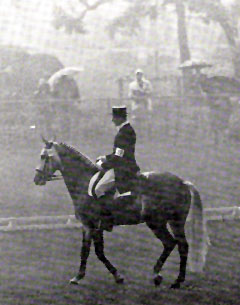 What happened then was an unforgettable part of German sport history and of dressage history in general. It was the material legends are made of: Neckermann and his mare gave an outstanding performance under worst circumstances. As soon as both entered the stadium the sky darkened threateningly. Pracht, who had travelled with her father to Tokyo and experienced it first hand, reminisced the historical moment: “when my father rode Antoinette around the dressage arena right before the start of his ride the heaven discoloured. First it became black and dark, then immediately it was completely yellow which made everything look ghost like. Heaven opened and a heavy monsoon came down. I very clearly remember that I had been absolutely convinced that this was the end of the world. Never before had I seen something like this, a heaven of such strange colouring, really frightening! Soon there was a big restlessness, everybody opened umbrellas and the Japanese put on white rain capes making them look like dangerous ghosts in that kind of light. Even the big TV camera at C got a white cape and looked very dangerously.”
What happened then was an unforgettable part of German sport history and of dressage history in general. It was the material legends are made of: Neckermann and his mare gave an outstanding performance under worst circumstances. As soon as both entered the stadium the sky darkened threateningly. Pracht, who had travelled with her father to Tokyo and experienced it first hand, reminisced the historical moment: “when my father rode Antoinette around the dressage arena right before the start of his ride the heaven discoloured. First it became black and dark, then immediately it was completely yellow which made everything look ghost like. Heaven opened and a heavy monsoon came down. I very clearly remember that I had been absolutely convinced that this was the end of the world. Never before had I seen something like this, a heaven of such strange colouring, really frightening! Soon there was a big restlessness, everybody opened umbrellas and the Japanese put on white rain capes making them look like dangerous ghosts in that kind of light. Even the big TV camera at C got a white cape and looked very dangerously.”
Can there be anything more worse for the sport than ride an Olympic GP under such extreme weather conditions and on a horse which was easily frightened and tense?
German chef d’equipe, general Horst Niemack, asked to delay the competition because it was unfair conditions, but the jury refused and Neckermann had to perform in thick fog drawning in rain. “My father was aware that he could not reach out for individual medals under such conditions, but he had to fight for the team medal, which he achieved with a clear ride, of course without major highlights. It was a miracle that Antoinette went through the programme under such circumstances without being spooky or making mistakes. My father was most grateful to his Antoinette and rewarded her with a big hug after the ride.” It was a proof of the extraordinary faith the grey mare had in his rider staying with him all the time instead of running away from the “terror”.
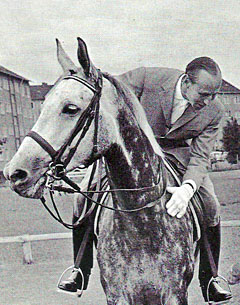
Her 6th place secured the team gold medal, Neckermann’s first Olympic gold medal.
The Olympics finished somewhat consoling when Antoinette improved by one place in the Spécial, though she had not forgotten the awful experience on Grand Prix day.
Funnily most Germans may not remember Antoinette because of her bravery in Tokyo, but because of an appearance in the popular TV sport programme called “Aktuelles Sportstudio” on the German ZDF channel. Moderator Wim Thoelke did an interview for this programme with Neckermann after his ride at Wiesbaden in the spring. Thoelke, knowing nothing about horses, considered dressage a sport in which rich people buy horses trained like poodles in the circus. Of course Josef Neckermann could not accept this and invited Thoelke to mount Antoinette to experience how difficult dressage riding is. Thoelke mounted the mare and sat down in the saddle heavily which made Antoinette anxious. As a reaction Thoelke clamped with his calves and Antoinette started to rear and jump sideways, the heavy showmaster hanging on for dear life. Neckermann was able to calm her down finally, but Thoelke was never heard again claiming nonsense about dressage. This historical clip is still very popular and shown now and then on ZDF.
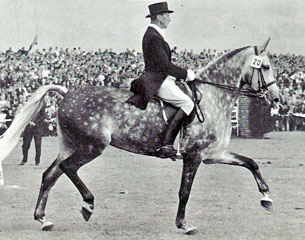 Antoinette continued her career with great success. In 1965 she won the Aachen Grand Prix again, this time ahead of Klimke’s Dux and Liselott Linsenhoff’s beautiful thoroughbred Monarchist xx and was on the winning German team at the European Championships in Copenhagen, where she also placed 5th individually.
Antoinette continued her career with great success. In 1965 she won the Aachen Grand Prix again, this time ahead of Klimke’s Dux and Liselott Linsenhoff’s beautiful thoroughbred Monarchist xx and was on the winning German team at the European Championships in Copenhagen, where she also placed 5th individually.
But at the end of 1965 she was out for some time because of a hock inflammation.
Though she won at Wiesbaden in May 1966 and placed 3rd at Aachen she faced a rival from her own stable: Mariano, this Arabic looking Westfalian by Ramzes AA. He had joined Neckermann’s string of horses and was nominated together with Antoinette for the first ever World Championships in Berne 1966. It was decided that Antoinette would be on the team and Neckermann could also start Mariano as an individual. For sure he rode the two most beautiful horses in the field and Mariano turned out to be the best of all, winning the GP while team horse Antoinette placed a very good 4th and contributed to Germany’s team gold medal.
After Mariano’s individual World Champion’s title everybody expected him to take over from Antoinette the next season, but the grey sustained laminitis and was out for some time. So Neckermann rode his Holstein mare one more time in the 1967 European Championships at Aachen, where she won the team gold again. But Neckermann, according to his daughter, wasn’t that happy because Antoinette placed only 9th individually.
It was the end of a very successful partnership and the beginning of a new one, one Evi Pracht will always be grateful for. Of all of Josef Neckermann’s children she had always been the horsiest one and pursued a career as a dressage rider. The only thing missing for the young lady was a Grand Prix horse, a schoolmaster from which she could feel and learn the highest level movements.
Her father had been aware of this. He took Antoinette’s hock issues into consideration and because he had the ride on Mariano himself he decided to hand the Holsteiner over to his talented daughter. Evi was over the moon to get this dreamlike mare to compete on: “Of course I had been the happiest person alive to get Antoinette. I felt on cloud nine when I sat on her and I immediately put her in my heart,” she said. “Finally I had a Grand Prix horse and such a beautiful and good one! She had some minor health issues then, but together with my very good vet we soon had it under control and I enjoyed 3,5 years at the highest level with this fine mare!”
Three very happy years for the ladies’ duo followed. Antoinette and Evi fitted together perfectly because Evi has always been good with mares and loved hers dearly. The national coach at that time, Bubi Günther, trained her once a week and success came soon, also on the international stage.
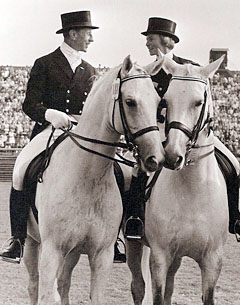 Evi remembers two achievements in particular: Her third place at the 1969 CDIO Aachen and her silver medal at the German Championships the same year. “Until today my most wonderful success was the third place in the Aachen Grand Prix. I shall never forget what happened in the lap of honour in the main stadium, which is so big. At the end Antoinette was very tense with all the people and the applause and tried to bolt away. My father had been second with Mariano and I almost overtook him. When we came out of the stadium and walked the horses back to the stables my father said to me that he cannot understand why I was not able to hold Antoinette back as he had ridden her with reins in one hand. When I heard this I could not hold myself any longer and told him that in first position it was an easy thing to hold Antoinette because there is no other horse to overtake. My father was really spoilt, he mostly rode first in the lap of honour.”
Evi remembers two achievements in particular: Her third place at the 1969 CDIO Aachen and her silver medal at the German Championships the same year. “Until today my most wonderful success was the third place in the Aachen Grand Prix. I shall never forget what happened in the lap of honour in the main stadium, which is so big. At the end Antoinette was very tense with all the people and the applause and tried to bolt away. My father had been second with Mariano and I almost overtook him. When we came out of the stadium and walked the horses back to the stables my father said to me that he cannot understand why I was not able to hold Antoinette back as he had ridden her with reins in one hand. When I heard this I could not hold myself any longer and told him that in first position it was an easy thing to hold Antoinette because there is no other horse to overtake. My father was really spoilt, he mostly rode first in the lap of honour.”
The German Championships the same year could have been the sad end of the mare’s career as she was kicked in the stable passage by Mitsouko, Ilsebill Becher’s talented mare. Antoinette sustained a deep cut which bled terribly and the vet had to come out and stitch the awful wound. Luckily no bone was injured, Antoinette was sound and passed the vet. check She then showed, according to Evi, one of her best rides ever to win the individual silver medal behind Mitsouko. “At the German Championships in Berlin Antoinette once again showed that she was honest and always trying, but at the same time had to be pressed forward all the time by me when she saw something that frightened her. In Berlin my thighs were trembling after the ride because I had to push her so much,” Evi admitted.
Antoinette was finally retired at the age of 16 in 1971 after the hock issues troubled her more and more. The Neckermanns decided to breed her because of her beauty, talent and superb character. “We thought that such a mare would produce great foals, but it wasn’t meant to be”. First Antoinette was covered by the Ramzes AA- son Römischer Prinz, but unluckily delivered twin fillies. One had to be put down due to a hoof deformation and the remaining one was handed over to the grandchild of Neckermann’s long-time groom Baranowski. Antoinette’s second foal was by the great thoroughbred sire Cardinal xx, but also Ceci Bon did not become very tall.
Evi gave it one last try, this time with the more massive Hanoverian Wöhler-son Wotan. “I was there when Antoinette delivered her last foal and I could not believe my eyes when she gave birth to the a little filly in a standing position. We took the utmost care to hold the foal with our hands so that it would not drop down into the straw. I christened the beautiful mare Angelique because I read the identically titled book at that time”, she reported.
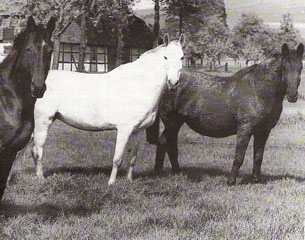 Antoinette spent the rest of her life at Evi Pracht’s stable asthe undoubted queen of the property, loved, admired and spoilt to her very last day. Because Antoinette had suffered horribly after her second foal, Ceci Bon, was weaned Evi decided “to do something very unprofessional” and decided not to split her from Angelique, who also did not grow into a very big horse: “Antoinette and Angelique lived together for the last three years. I was so happy to see my Antoinette being happy with her little daughter.”
Antoinette spent the rest of her life at Evi Pracht’s stable asthe undoubted queen of the property, loved, admired and spoilt to her very last day. Because Antoinette had suffered horribly after her second foal, Ceci Bon, was weaned Evi decided “to do something very unprofessional” and decided not to split her from Angelique, who also did not grow into a very big horse: “Antoinette and Angelique lived together for the last three years. I was so happy to see my Antoinette being happy with her little daughter.”
When Antoinette had to be put down in 1977 at the age of 22 Holstein’s most beautiful dressage mare had died. A horse that had given especially Evi Pracht so much: “Antoinette, who I think could stand the comparison with today’s dressage horses, had given me great faith and safety in the dressage arena and had shown me how to train my young horses up to Grand Prix. We were one heart and soul.”
Article by Silke Rottermann
Photos © Evi Pracht, Klaus Wagner, Menzendorf, unknown
More photos and stories about Neckermann's Antoinette in "Josef Neckermann" by Carl- Friedrich Mossdorf, published 1969 by Copress- Verlag, Munich
Related Links
Mariano, the First World Champion in Dressage
Absent, An Akhal Teke on the Olympic Stage